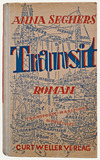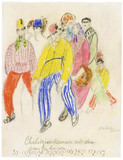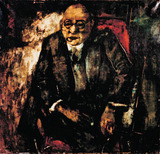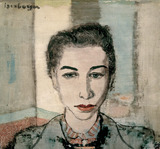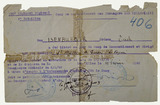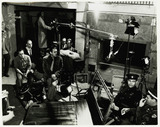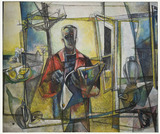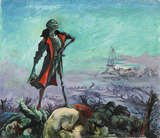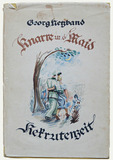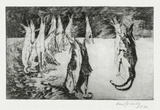Anna Seghers: Transit (1948)
Anna Seghers’ novel Transit is one of the most important literary works focusing on exile as its theme, in which the author worked through the impact of her own escape. It was written from 1941 to 1942 and was published initially in 1944 in English and Spanish.
Else Lasker-Schüler: Chaluzim kommen aus den Orangenhainen (c. 1935)
Prince Jussuf and his friends come to lifeElse Lasker-Schüler was in exile in Switzerland from April 1933. Her drawings were removed from the Berlin National Gallery in the wake of the "Degenerate Art" policy in 1937.
Eric Isenburger: Paul Westheim, painting (circa 1932)
Eric Isenburger moved to Berlin in 1931, and between then and 1933, his output primarily took the form of portraits of his intellectual contemporaries and artist friends. Among them is the oil painting Paul Westheim, which depicts the successful art critic, art historian, publisher and collector of modern art.
Eric Isenburger: Porträt Eva Marcu (1937)
In the early years of their exile, Eric and Jula Isenburger lived off an inheritance and had no financial worries. This was particularly helpful since the painter Eric Isenburger was suffering from a creative crisis.
Eric Isenburger: Release document Les Milles (1940)
Internment and escapeIn September 1939, Eric Isenburger responded to a nationwide call for foreigners in France to report themselves for registration, whereupon he was interned in the Les Milles camp. Just under five months later he managed to secure his release with the help of the camp doctor.
Four in a Jeep (1951)
Hans Sahl’s collaboration on the scriptThe author Hans Sahl suffered from a lack of money and also a lack of professional prospects in exile in America. He was therefore very glad to receive the offer to collaborate on the screenplay of a Swiss film production.
Georg Meistermann: Der Maler (The Painter, 1941 – 1943)
Georg Meistermann was a student at Düsseldorf’s Art Academy when it was forced to toe the Nazi line in 1933. However, Meistermann did not want to fit in.
Georg Netzband, Der Sieger (Mai 1939)
For the painter Georg Netzband, life in Nazi Germany meant living with state repression. The indignities included surveillance and interrogations, house searches, defamation as a “degenerate” artist and bans on exhibiting his work and on foreign travel.
Georg Netzband: Knarre und Maid – Rekrutenzeit (1938)
A work on the “list of damaging and undesirable writing”Due to supposed political unreliability, Georg Netzband was subjected to repression in the form of interrogations as well as searches of his house and studio. The situation escalated to such a point over the years that he began to seek a means of temporarily escaping the persecution. So in 1938, he took part in a military exercise lasting several weeks.
Hans Grundig: Das Lied der Wölfe, etching (The Song of the Wolves, 1938)
The couple Hans and Lea Grundig began an underground life in 1933, withdrawing into a domestic exile. They entertained thoughts of escaping but the two anti-fascists saw their task as supporting resistance within Germany.
